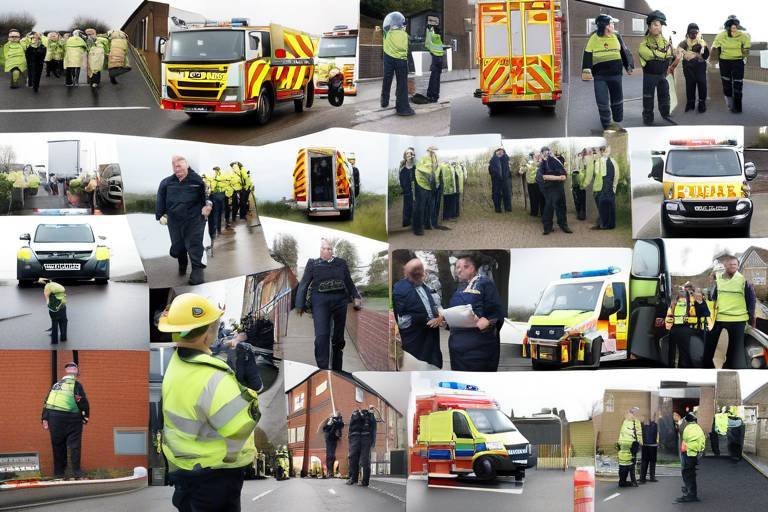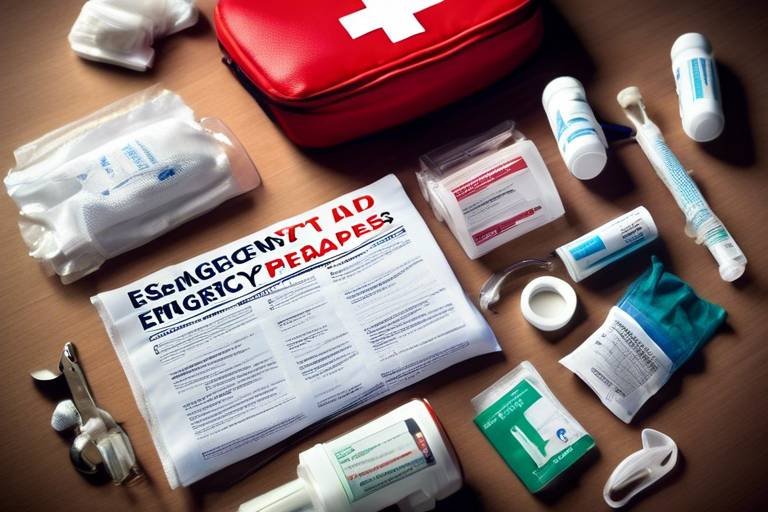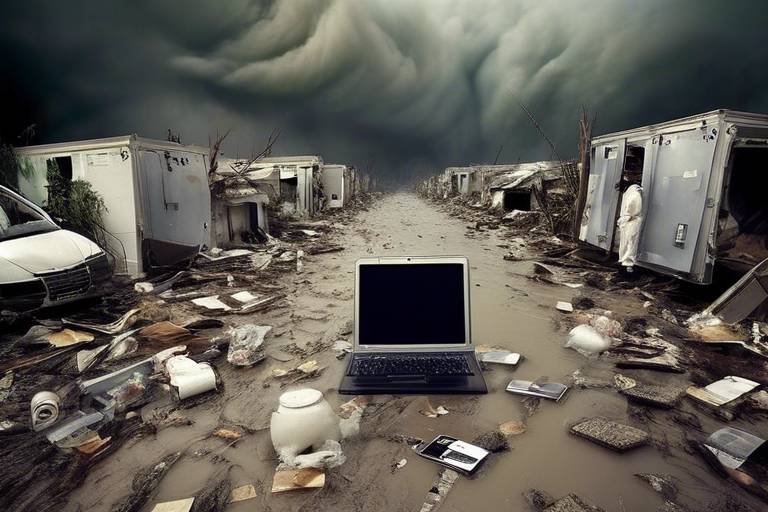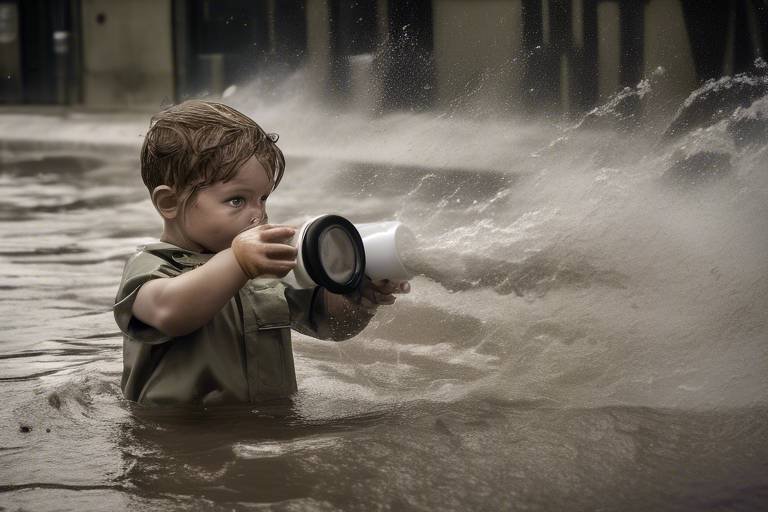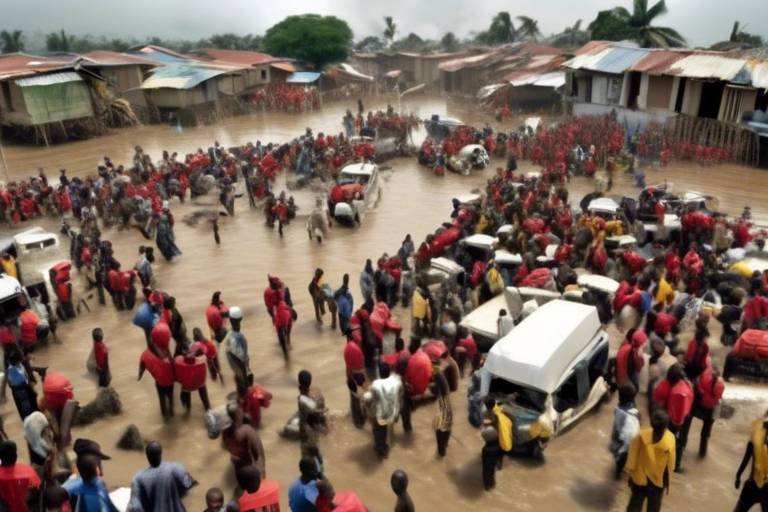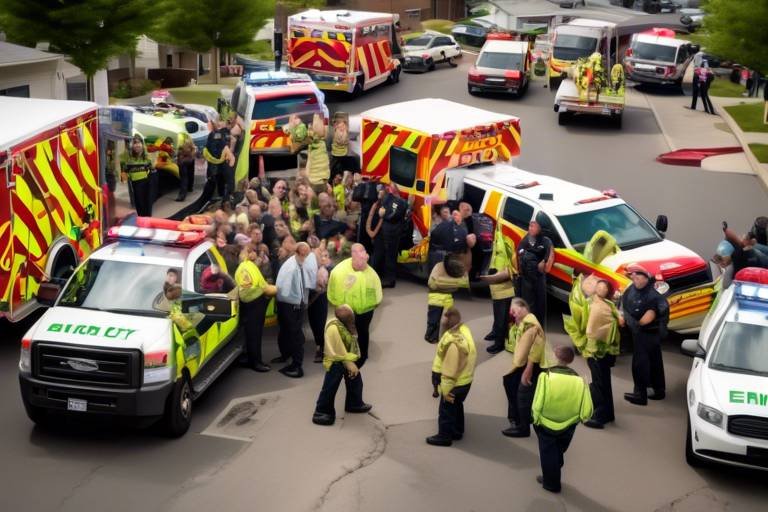Importance of Crowd Control During Disasters
When disaster strikes, whether it's a natural calamity like an earthquake or a man-made event such as a large-scale accident, the immediate response can often dictate the outcome. One of the most critical aspects of managing these situations is crowd control. Why is this so important? Imagine a chaotic scene where panic reigns, and individuals are scrambling for safety. In such moments, the lack of effective crowd management can lead to further injuries or even fatalities. Therefore, understanding the significance of crowd control during disasters is not just beneficial; it’s essential.
Crowd control serves multiple purposes during emergencies. First and foremost, it helps to maintain order and safety. When people are in distress, their reactions can be unpredictable. By implementing crowd control measures, emergency responders can guide individuals to safe zones, preventing dangerous bottlenecks and ensuring that evacuation routes remain clear. Furthermore, effective crowd management can facilitate the work of emergency services, allowing them to reach those in need more efficiently. It’s like conducting a symphony; each element must work in harmony to create a safe environment.
Additionally, crowd control plays a vital role in the dissemination of information. In a disaster situation, timely and accurate communication can save lives. Consider this: if a fire breaks out in a crowded venue, clear instructions on evacuation routes can mean the difference between life and death. By employing crowd control strategies, responders can ensure that critical messages are delivered effectively, reducing confusion and panic among the masses. This is where the importance of planning and training comes into play, as responders must be prepared to act swiftly and decisively.
Moreover, the psychological aspect of crowd control cannot be overlooked. During disasters, people are often overwhelmed by fear and uncertainty. By establishing a sense of order, crowd control measures can help alleviate some of that anxiety. When individuals see organized efforts to manage the situation, they are more likely to remain calm and follow instructions. This is why training personnel involved in crowd management is crucial; they need to be equipped not only with the skills to direct crowds but also with the ability to communicate reassurance in high-stress situations.
In conclusion, the importance of crowd control during disasters cannot be overstated. It is a multifaceted approach that enhances safety, facilitates communication, and provides psychological support to those affected. As we continue to face various emergencies, investing in effective crowd control strategies will undoubtedly lead to better outcomes for individuals and communities alike. The next sections will delve deeper into understanding crowd dynamics, effective strategies, and the challenges faced during such critical times.

Understanding Crowd Dynamics
Crowd dynamics is a fascinating field that studies the behavior and movement patterns of groups of people in various situations. Imagine a bustling concert where thousands of fans are eagerly waiting for their favorite band to take the stage. In such a scenario, understanding how the crowd behaves—how they move, react, and interact—is crucial. This knowledge becomes even more vital during disaster situations, where the stakes are high, and chaos can erupt in an instant.
When a disaster strikes, whether it be a natural calamity or a man-made emergency, the way people respond can be unpredictable. Factors such as fear, panic, and urgency can lead to erratic behavior, making effective crowd control a challenging task. To mitigate these risks, emergency responders must have a solid grasp of crowd dynamics. This understanding allows them to anticipate movements, identify potential bottlenecks, and implement strategies that keep the crowd safe and orderly.
Several key elements contribute to crowd dynamics, including:
- Group Size: The larger the crowd, the more complex the dynamics become. Large groups can create pressure points that lead to dangerous situations.
- Density: High-density areas can cause individuals to feel trapped, increasing anxiety and leading to panic.
- Behavioral Influences: Emotions play a significant role in how crowds behave. Fear can lead to stampedes, while a sense of community can promote cooperation.
By analyzing these elements, emergency planners can create tailored strategies to manage crowds effectively. For instance, during an evacuation, understanding that people tend to follow the crowd can help in designing clear exit routes and signage. Moreover, incorporating crowd management techniques such as barriers, designated pathways, and trained personnel can significantly improve safety outcomes.
In conclusion, grasping the intricacies of crowd dynamics is essential for effective crowd control during disasters. It equips responders with the tools needed to minimize chaos and enhance safety, ultimately saving lives in critical situations. As we continue to learn from past events and refine our approaches, the importance of understanding crowd behavior will only grow, ensuring that we are better prepared for the unexpected.

Strategies for Effective Crowd Control
When disaster strikes, the chaos that follows can be overwhelming. However, implementing effective crowd control strategies can significantly enhance safety and efficiency in such dire situations. The first step in this process is thorough planning. This involves assessing potential risks, understanding the environment, and anticipating crowd behaviors. Planners must consider factors such as location, the nature of the disaster, and the demographics of the crowd. By doing so, they can develop tailored strategies that address specific needs and challenges.
Communication is another cornerstone of effective crowd control. During emergencies, clear and timely information can make all the difference. Utilizing various communication methods, such as loudspeakers, social media updates, and mobile alerts, can help convey critical instructions to the public. For instance, imagine a situation where an earthquake has just struck. If emergency personnel can quickly inform people about safe evacuation routes or areas to avoid, the likelihood of panic and chaos diminishes significantly. Moreover, establishing a two-way communication channel allows responders to receive real-time feedback from the crowd, enabling them to adapt their strategies on the fly.
In recent years, technology has emerged as a game-changer in crowd management. Tools such as real-time tracking systems and automated alert systems can enhance situational awareness and response times. For example, drones can be deployed to monitor crowd movements from above, providing valuable insights that help emergency services make informed decisions. Additionally, mobile apps can push notifications to users about safety measures, updates, or changes in the situation. The integration of technology not only streamlines operations but also empowers individuals to make informed choices during emergencies.
Another crucial aspect of effective crowd control is the training of personnel involved in managing crowds. Proper training equips responders with the necessary skills to handle various scenarios confidently. This training should encompass a wide range of topics, including crowd psychology, conflict resolution, and emergency response protocols. By simulating real-life situations in training exercises, personnel can gain hands-on experience that prepares them for the unpredictability of actual disasters. A well-trained team can maintain order, provide assistance, and reassure the public, ultimately fostering a sense of safety amidst the chaos.
In conclusion, effective crowd control during disasters relies on a multifaceted approach that includes planning, communication, technology, and training. By implementing these strategies, emergency responders can significantly reduce chaos and enhance safety for everyone involved. As we continue to learn from past experiences and adapt to new challenges, the importance of these strategies cannot be overstated. They are not just methods; they are lifelines that can save lives and ensure a more organized response during some of the most critical moments.

Communication Techniques
In the chaos of a disaster, clear communication can be the difference between safety and panic. When people are faced with emergencies, their instincts often kick in, leading to confusion and a rush to safety. To mitigate this, emergency responders must employ effective communication techniques that convey critical information swiftly and accurately. Imagine a ship navigating through a storm; the captain’s orders must be loud and clear to ensure everyone knows their role and can act accordingly. In similar fashion, during a disaster, clear directives can help guide the crowd and prevent chaos.
One of the most effective ways to communicate during emergencies is through multi-channel approaches. This means utilizing various methods to reach as many people as possible. For instance, information can be disseminated via:
- Public Address Systems: Loudspeakers can broadcast crucial messages to large groups, ensuring that everyone hears the information.
- Mobile Alerts: SMS or app notifications can provide real-time updates directly to individuals’ phones, making sure they receive information even if they are not in earshot of loudspeakers.
- Social Media: Platforms like Twitter and Facebook can be used to spread information quickly and widely, reaching those who may not be in immediate danger but still need to know what is happening.
Moreover, the language used in these communications is just as important as the medium. Messages should be simple, direct, and actionable. For example, instead of saying, “Please move to the nearest exit,” a more effective message would be, “Evacuate through the nearest exit now!” This creates a sense of urgency and clarity, prompting immediate action.
Another vital aspect of effective communication is non-verbal cues. Body language, gestures, and visual signals can enhance understanding, especially when people are in a state of panic. For instance, emergency personnel can use hand signals to direct crowds, ensuring that instructions are understood even when voices are drowned out by noise.
Finally, it’s essential to establish a feedback loop during emergencies. This means creating channels through which individuals can ask questions or report their status. For example, designated personnel can be stationed throughout the crowd to answer queries and provide reassurance. This not only helps to clarify any uncertainties but also fosters a sense of community and support among individuals facing the crisis together.
In conclusion, mastering communication techniques during disasters is crucial for effective crowd control. By utilizing multiple channels, simplifying messages, incorporating non-verbal cues, and establishing feedback mechanisms, emergency responders can maintain order and ensure the safety of the public. The goal is to transform the chaotic environment of a disaster into one where information flows freely and people can act decisively.

Use of Technology
In the world of crowd control during disasters, technology is not just a luxury; it's a necessity. Imagine being in a chaotic situation where every second counts—having the right tools can mean the difference between safety and disaster. Technology enhances our ability to manage crowds effectively, enabling emergency responders to maintain order and ensure safety.
One of the most significant advancements is the use of real-time tracking systems. These systems allow emergency personnel to monitor crowd movements through various tools, such as drones and GPS-enabled devices. By gaining insights into crowd density and flow, responders can make informed decisions about where to deploy resources. This proactive approach not only helps in managing the crowd but also in redirecting individuals to safer areas when necessary.
Moreover, automated alert systems serve as a vital communication bridge between authorities and the public. During a disaster, clear and timely communication can mitigate panic and confusion. These systems can send out mass notifications via text, social media, or dedicated apps, providing real-time updates and instructions. For instance, if a crowd is moving toward a hazardous area, an automated alert can redirect them to safety, effectively reducing the risk of injuries.
Another innovative tool is the use of crowd simulation software. This technology allows planners to model various disaster scenarios and predict crowd behavior. By analyzing different variables—such as location, time of day, and type of disaster—emergency services can develop tailored strategies for crowd management. This foresight is invaluable, as it equips responders with the knowledge to anticipate challenges and act swiftly.
Not to be overlooked are the advancements in social media analytics. During a crisis, social media platforms often become the pulse of public sentiment. By monitoring these channels, emergency services can gauge the mood of the crowd and identify potential hotspots of unrest or panic. This data can guide decision-making and help authorities address concerns before they escalate.
In conclusion, technology is revolutionizing the way we approach crowd control in disaster situations. From real-time tracking to social media monitoring, these tools not only enhance the efficiency of emergency responses but also significantly improve public safety. As we continue to innovate, the integration of technology in crowd management will undoubtedly play a pivotal role in shaping a safer future.
- What types of technology are most effective for crowd control during disasters?
Effective technologies include real-time tracking systems, automated alert systems, crowd simulation software, and social media analytics.
- How can automated alerts help in a disaster situation?
Automated alerts provide real-time updates and instructions to the public, helping to reduce panic and guide individuals to safety.
- What role does social media play in crowd management?
Social media provides insights into public sentiment and potential areas of unrest, allowing emergency services to address issues proactively.

Training Personnel
Effective crowd control during disasters hinges on the preparedness of the personnel involved. This is where becomes a vital aspect of disaster management. Imagine being in a chaotic situation where every second counts; the ability of responders to act decisively can mean the difference between safety and disaster. Thus, training programs must be comprehensive, focusing on both theoretical knowledge and practical skills.
Training should encompass various aspects of crowd management, including but not limited to:
- Understanding Crowd Behavior: Personnel need to grasp how crowds behave under stress. This includes recognizing signs of panic and understanding how to mitigate it.
- Communication Skills: Clear and effective communication can significantly reduce confusion. Training should include techniques for delivering concise instructions and using various communication tools.
- Use of Technology: Familiarity with crowd management technologies, such as drones for aerial surveillance or apps for real-time updates, is crucial.
- First Aid and Emergency Response: Personnel should be trained in basic first aid and emergency response protocols to assist injured individuals promptly.
Moreover, simulation exercises can be an invaluable tool in training personnel. These exercises allow responders to practice their skills in a controlled environment, mimicking real-life scenarios. The more realistic the simulation, the better prepared they will be when faced with an actual disaster. For example, role-playing different crowd situations can help personnel develop their decision-making skills and improve their ability to work as a cohesive team.
In addition to initial training, ongoing education is essential. As new technologies and strategies emerge, personnel must stay updated to remain effective. Regular workshops, refresher courses, and participation in disaster drills can help maintain a high level of readiness. This continuous learning approach not only enhances skills but also fosters a culture of preparedness within the organization.
Ultimately, investing in personnel training is not just a checkbox on a to-do list; it’s a critical investment in public safety. When personnel are well-trained, they can respond to emergencies with confidence and efficiency, ensuring that crowds are managed effectively and safely. This proactive approach to training can significantly mitigate the risks associated with crowd dynamics during disasters.
Q1: Why is training personnel important for crowd control during disasters?
A1: Training personnel is crucial because it equips them with the necessary skills and knowledge to manage crowds effectively, reducing chaos and enhancing safety during emergencies.
Q2: What types of training should personnel receive?
A2: Personnel should receive training in understanding crowd behavior, communication skills, use of technology, and first aid. Simulation exercises are also highly beneficial.
Q3: How can ongoing training improve crowd control efforts?
A3: Ongoing training ensures that personnel stay updated on the latest techniques and technologies, enhancing their ability to respond effectively to emergencies.

Challenges in Crowd Control
Crowd control during disasters is no walk in the park. It’s like trying to herd cats—each individual has their own thoughts, feelings, and reactions, which can lead to unpredictable behavior. One of the biggest challenges is the unpredictability of human behavior. In high-stress situations, people often react in ways that are difficult to anticipate. For instance, when an alarm sounds or a natural disaster strikes, individuals might panic, leading to a rush towards exits or safe zones. This chaotic movement can create bottlenecks and increase the risk of injuries.
Additionally, emotional responses can complicate crowd management. Fear, anxiety, and confusion are common reactions during emergencies, and they can lead to irrational decision-making. Imagine a scenario where a crowd hears a loud noise—some may freeze, while others might push forward, creating a dangerous situation. Understanding these emotional triggers is crucial for those in charge of crowd control.
Environmental conditions can also pose significant challenges. Weather, terrain, and the layout of the area can all affect how crowds behave. For example, slippery surfaces due to rain or snow can lead to falls and injuries, while poorly lit areas can create confusion and fear. Emergency responders must be prepared to adapt their strategies based on these conditions, which requires quick thinking and flexibility.
Moreover, the size of the crowd can greatly impact control efforts. Larger crowds are inherently more difficult to manage, and the risk of chaos increases exponentially as the number of people rises. In situations where crowds gather for events or during evacuations, the sheer volume can overwhelm even the most well-prepared teams. This is where effective planning becomes essential. For instance, deploying personnel strategically throughout the area can help maintain order and provide immediate assistance where needed.
To illustrate these challenges, consider the following table, which summarizes key factors that complicate crowd control:
| Challenge | Description |
|---|---|
| Unpredictability | Human behavior can be erratic during emergencies, leading to unexpected movements. |
| Emotional Responses | Panic and fear can cause irrational actions, complicating control efforts. |
| Environmental Conditions | Weather and terrain can affect crowd behavior and safety. |
| Crowd Size | Larger crowds pose greater risks and require more resources for effective management. |
In conclusion, while the challenges of crowd control during disasters are significant, understanding these factors allows emergency responders to develop better strategies. By anticipating human behavior, acknowledging emotional responses, and preparing for environmental variables, authorities can enhance their ability to maintain order and ensure public safety. It’s a complex puzzle, but with the right pieces in place, it can be solved.
- What is crowd control? Crowd control refers to the techniques and strategies used to manage large groups of people, especially during emergencies.
- Why is crowd control important during disasters? Effective crowd control can minimize chaos, reduce injuries, and ensure a safe evacuation during emergencies.
- What are some common challenges in crowd control? Challenges include unpredictability of behavior, emotional responses, environmental conditions, and the size of crowds.
- How can technology assist in crowd control? Technology can provide real-time tracking, automated alerts, and communication tools to help manage crowds effectively.

Case Studies of Successful Crowd Management
When we think about disasters, whether natural or man-made, the chaos that can ensue is often overwhelming. However, there are shining examples of effective crowd management that not only minimized panic but also saved lives. One of the most notable instances occurred during the 2011 Tōhoku earthquake and tsunami in Japan. The Japanese authorities implemented a well-coordinated crowd control strategy that involved pre-established evacuation routes and clear signage. This meticulous planning allowed thousands to evacuate swiftly, showcasing how preparation can make a world of difference in chaotic situations.
Another remarkable case study can be drawn from the 2012 London Olympics. The event was a potential powder keg for crowd-related issues, but the organizers deployed an extensive crowd management plan that included real-time monitoring and communication systems. They utilized a combination of social media and traditional methods to keep attendees informed about crowd density and potential hazards. This proactive approach not only kept the peace but also created a positive atmosphere, demonstrating that effective crowd management can enhance the overall experience even in large gatherings.
To further illustrate the impact of successful crowd management, let’s take a look at a table that summarizes key strategies employed during these events:
| Event | Strategies Implemented | Outcome |
|---|---|---|
| 2011 Tōhoku Earthquake | Pre-established evacuation routes, clear signage | Swift evacuation, minimized chaos |
| 2012 London Olympics | Real-time monitoring, social media updates | Positive atmosphere, enhanced safety |
These case studies not only highlight the importance of planning and communication but also emphasize the need for adaptability in crowd management strategies. Each disaster is unique, and what works in one scenario may not be applicable in another. Therefore, it is crucial for emergency managers to analyze past incidents and continuously evolve their strategies based on lessons learned. By doing so, they can develop a toolkit of best practices that can be tailored to the specific needs of future events.
In addition to these examples, we can look at the 2017 Manchester Arena bombing, where emergency services faced the daunting task of managing a crowd in the aftermath of an attack. The rapid response of first responders and their ability to direct the crowd away from danger played a crucial role in ensuring safety. This incident serves as a stark reminder of the unpredictable nature of emergencies and the need for well-trained personnel who can think on their feet and maintain order amidst panic.
As we analyze these successful crowd management case studies, it becomes clear that the intersection of technology, communication, and proactive planning is essential. The lessons learned from these events can guide future preparations, ensuring that we are better equipped to handle the next crisis. In a world where disasters can strike at any moment, understanding and implementing effective crowd control strategies is not just beneficial—it is vital for saving lives.
Q: What are the key components of effective crowd management?
A: Effective crowd management involves clear communication, pre-established plans, real-time monitoring, and well-trained personnel.
Q: How can technology improve crowd control during disasters?
A: Technology can enhance crowd control through real-time tracking, automated alerts, and effective communication tools that keep the public informed.
Q: Why is training important for personnel involved in crowd control?
A: Proper training equips personnel with the skills needed to manage crowds effectively, respond to emergencies with confidence, and maintain order in chaotic situations.

Lessons from Major Disasters
When we look back at major disasters throughout history, we see a tapestry woven with both tragedy and triumph. Each incident offers invaluable lessons that can significantly enhance our approach to crowd control in future emergencies. For instance, during the 2011 Japan earthquake and tsunami, the rapid evacuation of coastal areas was a testament to the importance of pre-planning and effective communication. Authorities had established clear evacuation routes and protocols that were communicated well in advance, allowing for a more orderly and efficient evacuation process. This highlights the necessity of educating the public about emergency procedures long before a disaster strikes.
Another poignant example is the crowd control challenges faced during the 2015 Nepal earthquake. In the aftermath, the chaotic scenes at hospitals and shelters revealed the critical need for real-time information dissemination. People were often unsure where to go for medical help or safe refuge. This situation underscores the importance of utilizing technology, such as social media and mobile alerts, to keep the public informed during emergencies. Imagine a world where everyone receives timely updates on safe zones and available resources, drastically reducing confusion and panic.
Moreover, the 2017 Las Vegas shooting serves as a stark reminder of how quickly situations can escalate. In this case, the rapid response of emergency services, coupled with the implementation of crowd management strategies, played a crucial role in minimizing casualties. The lessons here revolve around the need for training and preparedness. Emergency personnel must be well-versed in managing crowds, especially in chaotic environments, where emotions run high and quick decisions are essential. The ability to maintain calm amidst chaos can be the difference between life and death.
In reflecting on these events, we can also draw parallels to the importance of community involvement. During the aftermath of Hurricane Katrina, local residents stepped up to assist in crowd control and resource distribution. This community engagement not only aided in managing the chaos but also fostered a sense of solidarity among those affected. It emphasizes the value of having trained volunteers who can assist authorities during disasters, turning the tide from mere survival to effective management of the situation.
To summarize, the lessons learned from major disasters can be distilled into several key points:
- Pre-planning and public education are essential for effective crowd control.
- Real-time communication can significantly alleviate confusion during emergencies.
- Training emergency personnel in crowd management is crucial for quick and effective responses.
- Community involvement enhances the overall effectiveness of crowd control efforts.
By embracing these lessons, we can better prepare ourselves for future emergencies, ensuring that safety and efficiency remain at the forefront of our disaster response strategies. Each disaster teaches us something new, and it is our responsibility to carry forward these lessons to create a safer environment for everyone.
Q: What are the key elements of effective crowd control during a disaster?
A: Effective crowd control involves pre-planning, clear communication, real-time information dissemination, and well-trained personnel. It’s essential to establish protocols and educate the public ahead of time.
Q: How can technology assist in crowd management?
A: Technology can enhance crowd management through real-time tracking, automated alerts, and social media updates. These tools help keep the public informed and reduce panic during emergencies.
Q: Why is community involvement important in disaster situations?
A: Community involvement fosters solidarity and enhances response efforts. Trained volunteers can assist emergency services, making the overall response more effective and organized.

Innovative Approaches to Crowd Control
In the ever-evolving landscape of disaster management, are not just beneficial; they are essential. As we face an increase in the frequency and intensity of disasters, the need for effective crowd management techniques becomes more critical. Traditional methods often fall short in chaotic environments, where every second counts and the stakes are incredibly high. So, what are some of these innovative strategies that can make a significant difference?
One of the most promising approaches is the use of drone technology. Drones equipped with cameras can provide real-time aerial views of crowded areas, allowing emergency responders to assess the situation from above. This bird's-eye perspective helps in understanding crowd density and movement patterns, which can inform better decision-making. Imagine being able to see a crowd's behavior from the sky—it's like having a superpower that can save lives!
Another innovative strategy is the implementation of mobile applications designed for disaster scenarios. These apps can serve multiple purposes, such as providing real-time updates to the public, alerting individuals to safe exit routes, and even allowing users to report emergencies. For example, during a natural disaster, a well-designed app can guide people away from danger zones and direct them to shelters. By harnessing the power of smartphones, we can transform ordinary citizens into informed participants in their own safety.
Moreover, social media platforms have emerged as critical tools for crowd control. They facilitate rapid dissemination of information and can be used to communicate essential updates during emergencies. For instance, a simple tweet can provide guidance on evacuation routes or alert people to potential hazards. The challenge lies in ensuring that the information shared is accurate and timely, but with the right protocols in place, social media can be a game-changer.
Additionally, the integration of artificial intelligence (AI) into crowd management systems is making waves. AI algorithms can analyze vast amounts of data to predict crowd behavior and identify potential risks. For example, by analyzing past crowd movements during similar events, AI can help predict where bottlenecks may occur, allowing emergency services to proactively manage these situations before they escalate.
To illustrate the effectiveness of these innovative approaches, consider the following table that highlights some successful implementations:
| Technique | Description | Impact |
|---|---|---|
| Drone Surveillance | Real-time aerial monitoring of crowd behavior. | Improved situational awareness for responders. |
| Mobile Apps | Information dissemination and emergency reporting. | Enhanced public engagement and safety. |
| Social Media | Rapid updates and communication with the public. | Timely information reduces panic. |
| AI Analysis | Predictive modeling of crowd behavior. | Proactive crowd management and risk mitigation. |
In conclusion, the integration of technology into crowd control strategies is not just a trend; it's a necessity. As we continue to innovate and adapt, these approaches will undoubtedly improve our ability to manage crowds effectively during disasters. By leveraging technology, we can create a safer environment for everyone involved, ensuring that in times of crisis, chaos can be transformed into order.
- What are the main benefits of using technology in crowd control?
Technology enhances situational awareness, improves communication, and allows for proactive management of crowds. - How can social media help during disasters?
Social media can quickly disseminate important information and updates, guiding the public on how to stay safe. - Are drones effective in all types of disasters?
Drones are particularly effective in large-scale disasters where aerial surveillance can provide critical insights.

The Role of Emergency Services
Emergency services are the backbone of crowd control during disasters, acting as the first line of defense in chaotic situations. Their presence is not just about enforcing order; it’s about ensuring safety and providing crucial support to those in need. Imagine a bustling crowd, panic setting in as a disaster unfolds. This is where emergency responders step in, equipped with training and resources that allow them to navigate the chaos effectively.
One of the primary responsibilities of emergency services is to coordinate efforts among various agencies. This includes police, fire departments, and medical teams, all working together to manage the flow of people and provide assistance. The synergy created by these agencies is vital for maintaining calm and ensuring that help reaches those who require it most. For instance, during a natural disaster like a hurricane, emergency services set up shelters, distribute supplies, and provide clear directions to evacuees, all while managing the crowd to prevent overcrowding and ensure safety.
Moreover, emergency services utilize a variety of strategies to communicate effectively with the public. This can include the use of loudspeakers, social media updates, and even mobile apps designed to provide real-time information. By keeping the public informed, they can significantly reduce panic and confusion, which are often the biggest hurdles in crowd control. For example, during a large-scale event or an evacuation, timely updates on safe routes and shelter locations can make a huge difference in managing the crowd’s movement.
In addition to communication, the training of emergency personnel is crucial. These individuals undergo rigorous training programs that not only focus on tactical skills but also on understanding human psychology. Recognizing the emotional state of a crowd can help responders to diffuse tense situations before they escalate. Understanding that a crowd can behave unpredictably, especially in high-stress environments, is key to effective management.
Furthermore, the integration of technology into crowd control strategies has revolutionized the way emergency services operate. For example, drones can be deployed to survey large areas, providing real-time data on crowd density and movement patterns. This allows emergency services to adjust their strategies on the fly, ensuring that resources are allocated where they are most needed. Additionally, mobile applications can be used to send alerts and instructions directly to individuals, further enhancing the efficiency of crowd management.
Ultimately, the role of emergency services extends beyond mere crowd control; they serve as a calming presence in the storm of chaos. Their ability to respond swiftly, communicate effectively, and work collaboratively with other agencies is what sets them apart. By understanding the dynamics of crowds and employing innovative strategies, emergency services not only protect lives but also restore order in the midst of disaster.
- What is the primary role of emergency services during a disaster?
Emergency services coordinate efforts among various agencies, provide assistance, and ensure public safety. - How do emergency services communicate with the public in chaotic situations?
They use loudspeakers, social media, and mobile apps to provide real-time updates and instructions. - Why is training important for emergency personnel?
Training equips responders with the skills to manage crowds effectively and understand human behavior in stressful situations. - How is technology utilized in crowd control?
Technology such as drones and mobile applications enhances real-time data collection and communication during emergencies.
Frequently Asked Questions
- What is crowd control during disasters?
Crowd control during disasters refers to the strategies and techniques employed to manage large groups of people in emergency situations. The goal is to maintain safety, minimize chaos, and ensure efficient evacuation or assistance.
- Why is understanding crowd dynamics important?
Understanding crowd dynamics is crucial because it helps responders anticipate how people will behave in stressful situations. By recognizing movement patterns and emotional responses, emergency services can implement more effective crowd management strategies.
- What are some effective strategies for crowd control?
Effective strategies for crowd control include thorough planning, clear communication, and the use of technology. These elements work together to guide crowds safely and efficiently during emergencies.
- How does technology aid in crowd management?
Technology aids in crowd management through tools like real-time tracking systems and automated alert notifications. These technologies improve situational awareness and response times, ultimately enhancing safety during disasters.
- What challenges do responders face in crowd control?
Responders may face challenges such as unpredictable crowd behavior, emotional reactions, and varying environmental conditions. These factors can complicate efforts to maintain order and ensure safety during emergencies.
- Can you provide examples of successful crowd management?
Yes! Case studies from past disasters show that effective crowd management can save lives. Analyzing these instances provides valuable insights and best practices for future disaster preparedness.
- What role do emergency services play in crowd control?
Emergency services play a pivotal role in crowd control by providing trained personnel, resources, and leadership. Their coordination efforts are essential for ensuring public safety in chaotic situations.
- How can personnel be trained for crowd control?
Personnel can be trained through specialized programs that focus on crowd management techniques, communication skills, and emergency response strategies. This training equips responders to handle crowds effectively during disasters.




